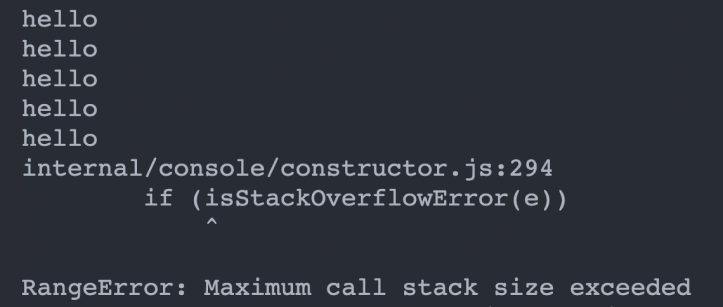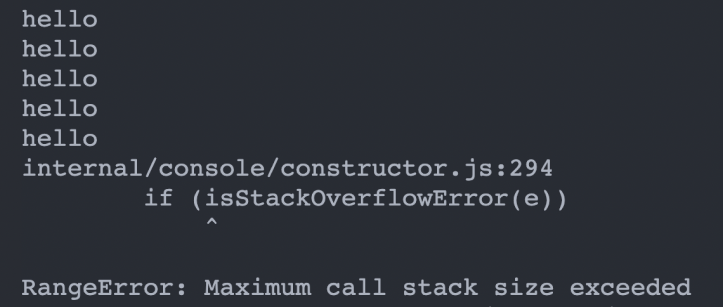Recursion works similarly to how loops do in JavaScript. Loops allow you to execute a set of code multiple times as long as a condition is true.
In this article, I will explain what Recursion is and how it works in JavaScript.
In loops, when the condition becomes false, the execution stops. If the condition for execution forever remains true, you get an infinite loop which can crash your application.
It's the same with recursion – as long as the condition for recursion remains true, recursion keeps happening until a condition stops it, else, you get an infinite recursion.
Here's a video version of this tutorial if you would like that: Recursion in JavaScript, Simplified
So, now let's dive in...
What is Recursion?
Recursion is a concept where a function calls itself, and keeps calling itself until it is told to stop.
Let's look at an example:
function printHello() {
console.log("hello")
}
printHello()
Here, we declare a printHello function that logs "hello" to the console. And then, we call the function after the definition.
In the case of recursion, we can also call the printHello function from within the printHello function like this:
function printHello() {
console.log("hello")
printHello()
}
printHello()
// hello - first function call
// hello - second function call
// hello - third function call
// and it goes on infinitely
This is recursion. So when JavaScript executes printHello(), "hello" is printed to the console, and afterward, printHello() is called again. Here's how the recursion happens:
printHello()is executed the FIRST time, "hello" printed to the console, and right there in the function,printHello()is called againprintHello()is executed the SECOND time,console.log("hello")runs again, andprintHello()is called againprintHello()is executed the THIRD time,console.log("hello")runs again, andprintHello()is called again- and it keeps going on and on until the call stack reaches its maximum and the app crashes:

Let's understand the meaning of this error.
What is the Call Stack?
The call stack is a mechanism that JavaScript uses to keep track of the function that is currently being executed.
When a function is called, it is added to the call stack. For example, this function from above:
function printHello() {
console.log("hello")
}
printHello()
When this function is to be executed, it is added to the call stack:
// printHello()
// ----
// call stack
After execution (when all the code runs, or when a return statement is encountered), the function is popped out of the stack:
// ----
// call stack
If the printHello function, for example, calls another function like this:
function printHi() {
console.log("hi")
}
function printHello() {
console.log("hello")
printHi()
}
printHello()
In this case, the call stack will look like this when printHello is called:
// printHello()
// ----
// call stack
After running the console.log("hello") line, the next line is printHi(), and this call is added to the top of the stack:
// printHi()
// printHello()
// ----
// call stack
After the printHi() call finishes execution, it is popped out of the stack:
// printHello()
// ----
// call stack
After printHello() finishes execution, it is also popped out of the stack:
// ----
// call stack
So how does recursion work with the call stack?
Recursion and the Call Stack
Back to our recursion code above:
function printHello() {
console.log("hello")
printHello()
}
printHello()
What happens here is, when printHello() is executed, it is added to the call stack:
// printHello()
// ----
// call stack
The console.log("hello") is executed, then printHello() is executed again, and is added to the top of the call stack:
// printHello()
// printHello() -- "hello"
// ----
// call stack
Now, we have two functions currently on the call stack: the first printHello and the second printHello which was called from the first one.
During the execution of the second printHello, console.log("hello") is executed, and printHello is called again. Now the stack looks like this:
// printHello()
// printHello() -- "hello"
// printHello() -- "hello"
// ----
// call stack
As things are, we do not have any condition that stops the recursion, so printHello continues calling itself and filling the stack:
// ...
// printHello() -- "hello"
// printHello() -- "hello"
// printHello() -- "hello"
// printHello() -- "hello"
// printHello() -- "hello"
// printHello() -- "hello"
// ----
// call stack
And then, we get the call stack size error:

To avoid this infinite recursion that maxes out the call stack, we need a condition that stops the recursion.
General Case and Base Case in Recursion
A General case (also called Recursive case) in recursion is the case that causes the function to keep recursing (calling itself).
A Base case in recursion is the halting point of the recursive function. It is the condition you specify to stop the recursion (just like stopping a loop).
Here's an example:
let counter = 0
function printHello() {
console.log("hello")
counter++
console.log(counter)
if (counter > 3) {
return;
}
printHello()
}
printHello()
Here, our general case is not stated explicitly, but implicitly: if the counter variable IS NOT GREATER than 3, the function should keep calling itself.
While the base case, explicitly stated, is, if the counter variable IS GREATER than 3, the function should end execution. This case will cause all the recursive functions on the call stack to be popped out, since the recursion has ended.
This is what the call stack would look like when printHello() is called the first time:
// printHello()
// ----
// call stack
Then "hello" is logged, the counter variable is incremented by 1 (which makes it 1), and the counter variable is also logged. The base case is checked. "counter is not greater than 3", so the condition isn't met yet.
The next line in the function is printHello() and in the call stack:
// printHello()
// printHello() -- "hello" -- 1
// ----
// call stack
"hello" is logged again, and the counter variable is incremented and also logged. The base case is not met as "counter is still not greater than 3". Then, the printHello() in the second function is called and the call stack looks like this:
// printHello()
// printHello() -- "hello" -- 2
// printHello() -- "hello" -- 1
// ----
// call stack
The same cycle happens, and printHello() is called again:
// printHello()
// printHello() -- "hello" -- 3
// printHello() -- "hello" -- 2
// printHello() -- "hello" -- 1
// ----
// call stack
After "hello" is logged to the console, counter is incremented by 1 (making it 4). "4 is greater than 3" which meets our base case, so the return statement is executed.
It doesn't matter what we are returning, but return stops the execution of a function. This means that the fourth printHello() in our call stack will not be able to call printHello() again as that line is not reached.
What happens next is that the fourth printHello() is popped out of the call stack as it has finished execution:
// printHello() -- "hello" -- 3
// printHello() -- "hello" -- 2
// printHello() -- "hello" -- 1
// ----
// call stack
For the third printHello(), after the line where it calls itself, there's nothing left in the function to be executed. So this means that the third printHello() has also completed its execution, and will be popped out of the call stack:
// printHello() -- "hello" -- 2
// printHello() -- "hello" -- 1
// ----
// call stack
Same thing for the second and first printHello(), thereby making the call stack empty:
// ----
// call stack
So you see how we have avoided an infinite recursion by providing a base case. A recursive function should have AT LEAST ONE BASE CASE (you can have as many as you want) to ensure that the recursion doesn't run forever.
There are different ways you can write base cases. Here is one where the general case is explicit, while the base case is implicit:
let counter = 0
function printHello() {
console.log("hello")
counter++
console.log(counter)
if (counter < 4) {
printHello()
}
return;
}
printHello()
Here, we have the general case which tells the function to keep recursing. The case here is if counter IS LESS than 4. So if this case is met, the recursion keeps happening.
But the base case which is not as explicit as the former example is if counter is NO LONGER LESS than 4, proceed to the next line. This executes return and the function ends. Then everything on the call stack starts popping off as they have completed execution.
Wrapping up
Recursion is not exactly a replacement for loops. But in some cases, recursion can be more effective and easier to read with fewer lines of code.
In this article, you've learned the concept of recursion, which is when a function calls itself for as long as a general case is met until a base case stops it. You've also seen how it compares to loops, and how it works with the call stack.
As a real-life example, check out my post here where I explain How to find the factorial of a number using Recursion in JavaScript

